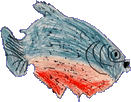



Teaching Under the Influence of FishIt all started quite innocently. A parent donated a fishtank. We took a fieldtrip to buy fish. Some fish died, some lived. We asked lots of questions. The questions prompted us to begin THE FISH PROJECT. The program and people behind Galileo gave me the courage to get started. Here is a bit of the result. A big jackfish kicked it off. After she thawed out in the water table, we spent the afternoon painting her in rainbow colours and making prints on large sheets of newsprint. I wanted the kids to taste cooked fish and somehow I ended up with a dull knife from the Home Ec room and fish intestines, surrounded by a crowd of kids, totally engrossed in the mess. Staff members walked in and recorded the event for posterity. Galileo staff took some of these photos and began posting them on the web. We deduced that the fish was a girl because she had “tons” of eggs inside. Most of us did taste the cooked jackfish flesh and had a good look at the bones, which helped us answer one of our questions, “How do fish move?” After we recorded all of our questions, the formal research began. Part of the Galileo process is a teacher’s list of websites the kids can access to find out more about fish We used library books and the internet which meant that I had to give the kids more freedom to walk down to the library or the computers. I also found myself using more non-fiction books to read aloud to the class. The students asked more questions and discussed possible answers, accepting input from everyone regardless of his/her grade level. There was a purpose to our work; neither teacher nor students were bored. A donation of several large fish was made by a student in another grade which spurred us onto more research. Students watched live video of sharks swimming in the ocean. They began to illustrate a particular fish. Even their best efforts were sent back for more work. Eventually, the results were easily recognizable. At this point, the Galileo people started taking the fish drawings and posting them on the web. We had our own site with our own work! As their artwork began to appear on the website the students worked even harder to finish their illustrations with colour and outline. With this attention to detail, and opportunity to spend time with books and specific internet sites, the students answered more of their questions. As family members saw the work on the internet, the community began to become involved. We visited a grandparent who had been keeping her pond fish indoors. We went fishing with High School buddies and grandparents. Parents and grandparents e-mailed us to comment on our work. Everyone seemed to know something about THE FISH PROJECT. Our year-end fieldtrip took us out to my fishpond to see the fishes released into a much larger environment. We began to work on a production we called Jonah and the Big Fish. Students had no reservations about using technology equipment such as digital cameras, recorders, and projectors. My fear of these machines subsided as the students and I practiced using them. The students worked together to rewrite the story, illustrate, narrate, and create sound effects. All the while, the students were snapping shots with the two digital cameras they shared. After going through the photos, I compiled a segment, The Making of Jonah and the Big Fish, which followed the story. The expressions on the faces speak volumes about the success of the project. Each child was totally engaged in the activity, collaborating with the rest of the class to complete the project. The last day of school we showed our work. With the addition of the behind the scenes snapshots, it was quite long. In spite of all the excitement of awards and the last day of school, the gym was silent for the presentation. We were proud to have entertained our audience and demonstrated some of our knowledge of fish. Is it over yet? I’m not sure. I think the students will remember parts of THE FISH PROJECT for the rest of their lives. I also think that my view of kids and technology has changed, and I know I have more respect for fish. The staff at Galileo were very patient and helpful, encouraging me throughout each step. I know this is the type of technology experience I will continue to offer my students because it gave them the opportunity for meaningful work. |